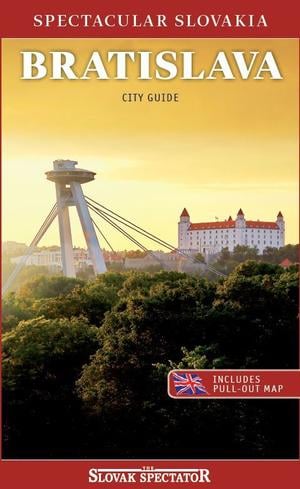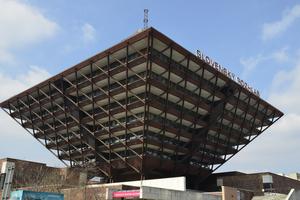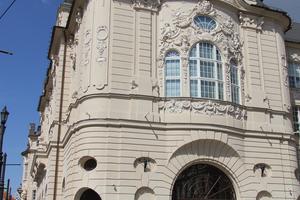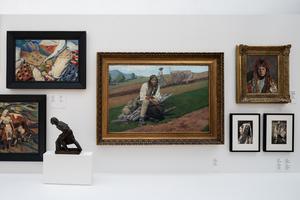You have access to this premium content thanks to ING Hubs Slovakia, the expert hub of global banking.
This article was published in the latest edition of our Bratislava City Guide, which can be obtained from our online shop with Spectacular Slovakia travel guides.
 Lost in Bratislava? Impossible with this City Guide! (source: Spectacular Slovakia)
Lost in Bratislava? Impossible with this City Guide! (source: Spectacular Slovakia)
If you are an incurable museumgoer or gallery lover, Bratislava, with plentiful such institutions and a busy event schedule, will suit you very well. Galleries in Bratislava are mostly situated in ex-palaces of noblemen, so the historical experience mixes with art, both old and modern. Since there are so many of these palaces here, there are many art galleries too, the best of which are the Slovak National Gallery, the Nedbalka Gallery, Danubiana and Bratislava City Gallery.
National gallery
The biggest and most important gallery is, unsurprisingly, the Slovak National Gallery in downtown Bratislava. In December 2022, it re-opened after a seven-year upgrade that has made it a gallery fit for the 21st century. Its second floor now houses permanent exhibitions, the first two of which, Sacred Art and Modern, opened in June 2023. A further four will open in the first half of 2024. In the meantime, the gallery’s other premises will host temporary exhibitions. The SNG’s Esterházy Palace features experimental and interactive displays. Art books, book guides and souvenirs can be purchased in the Ex Libris bookshop located next to the main entrance in the Water Barracks.
City gallery
In the centre of the Old Town, the Bratislava City Gallery occupies Pálffy Palace as well as Mirbach Palace. It hosts a rich collection of older works plus an array of contemporary pieces. A permanent exhibition entitled “Stories and Phenomena: 20th Century Slovak Fine Art II” offers a glimpse of modern art. It comprises two installations: “Passage” by Matej Krén and “Villa of Mysteries” by Alex Mlynárčik, both intriguing. “Passage” is essentially a pathway through an installation of mirrors and books, which create an illusion of an infinite space around the visitor, who is invited to walk along it. “Villa of Mysteries” is made also of mirrors and paintings that together create a maze, bathed in red. It is unlike anything else in the gallery. In addition to these installations, there are also permanent exhibitions showcasing Central European Painting and Sculpture 1800–1918, the Celtic mint in Bratislava, Tapestries from England, and a Picture Gallery. Combined they create an incredibly diverse collection – and they are not restricted only to the city centre.
Galleries in Bratislava
Danubiana Meulensteen Art Museum (www.danubiana.sk)
Nedbalka
“It reminds me of the Guggenheim gallery in New York, where I was sitting in front of Manet’s Before the Mirror for more than 30 minutes,” said Jana Meňušová, an enthusiastic traveller, sitting in the café of the Gallery Nedbalka, surrounded by books about Slovak painters. “It is much smaller but also much cheaper.”
The gallery opened in 2012, tucked away in an anonymous building on Nedbalova Street in the Old Town. Its riches only become apparent after paying a €6 entrance fee and proceeding to the first floor, when you are suddenly in a circular open-plan gallery surrounded by paintings and sculptures of Slovak artists mostly from the 20th century. The top floor is given over to the work of Ladislav Medňanský, from which you can peer over another three levels of galleries including the work of Ján Fulla, Ladislav Guderna or the Galanda group, among others. The entrance hall is used for temporary exhibitions. The gallery is fully accessible to disabled visitors via a lift to each floor.
Danubiana
Museums in Bratislava
The oldest shop in town (www.muzeumobchodu.sk/)
Bratislava City Museum; Museum of Viticulture; Museum of Historical Interiors (www.muzeumbratislava.sk)
Memorial House of Johann Nepomuk Hummel (www.muzeumbratislava.sk)
Museum of Pharmacy (Red Crayfish Pharmacy) (www.muzeumbratislava.sk)
Museum of Jewish Culture (www.snm.sk)
Archaeological Museum; Music Museum; Museum of Carpathian German Culture; Museum of Hungarian Culture in Slovakia (www.snm.sk)
Museum of Transport (www.muzeumdopravy.com)
Devín Castle (/www.visitbratislava.com)
Museum of Croatian Culture in Slovakia (www.snm.sk)
Gerulata (www.muzeumbratislava.sk)
On the northern corner of a windy, artificial island in the middle of the Danube, 15 km from downtown Bratislava, is the Danubiana Meulensteen Art Museum. This nest of modern art is accessible via car, bike or the No. 90 bus from the stop Nové SND near Eurovea.
The most popular part of Danubiana is the most remote end of the peninsula with the monumental 11-metre high glass mosaic Danube Wing. It is part of the sculpture park, where you can appreciate the artwork of world-renowned artists as well as Slovaks.The walk on the roof of the museum is another exceptional experience. At sunset, the panoramic view of Bratislava, the Small Carpathians and the majestic Danube River is simply unforgettable.
Museums
Numerous museums dotted across Slovakia are governed by the central Slovak National Museum organisation, and eight of them are in Bratislava.
These include the Natural History Museum, permanently exhibiting a huge number of objects of living and non-living nature, alongside other different temporary exhibitions. It is located on the embankment, close to the port and tiny park.
Žižkova Street, right under castle hill, is a home to four museums: the Archaeological Museum, the Music Museum and two others focused on the lives of Hungarian and Carpathian German minorities. There are also museums of Jewish and Croatian cultures in other parts of the city, also reflecting the life of ethnic minorities in Slovakia. Bratislava Castle is also part of the Slovak National Museum family, and houses temporary and permanent exhibitions that tell the story both of the fortress itself and the history of the territory known today as Slovakia. A tour inside concludes with a trip up the Crown Tower, which affords magnificent views over the city.
The Museum of Transport, next to the main railway station, hosts a variety of
Classical music in Bratislava
vehicles and accessories, such as old steam locomotives, snowploughs and other railway machines. Old warehouses are also stocked with cars, both old and modern, classics and prototypes, as well as motorbikes and bicycles. In short, everything that a transport or engineering nut might desire.
The Town Hall museums in the Old Town Hall focus on the history of the city as well as offering exhibits of wine and furniture in the nearby Apponyi Palace, where in cellars several winetasting programme are available. Michael’s Gate is another spot for history lovers. It is close to the Museum of Pharmacy located in the yellow building behind the gate. Closer to the castle is the picturesque House of the Good Shepherd which houses the Museum of Clocks. Two other museums in the historical centre are devoted to musician Johann Nepomuk Hummel and sculptor Arthur Fleischmann, both of whom were born in Bratislava. The city is also in charge of managing Devín Castle and the ruined foundations of a Roman military camp called Gerulata in Rusovce which was included on the UNESCO World Heritage Lists in 2021.
Music and theatre
Cultural life is also rich in Bratislava as far as concerts, festivals and exhibitions are concerned. During the summer months, a programme called Cultural Summer includes variety of concerts and happenings all over the Old Town. The highlight of every season is the re-enactment of coronations of Hungarian kings and queens. The Bratislava Jazz Days festival also draws the best jazzmen to Slovakia from all over the world.
Year round, the Slovak National Theatre is the jewel in Bratislava’s theatrical crown. It is housed in two buildings: the ornate, historical one on Hviezdoslavovo námestie (square) and a modern, well-appointed new construction next to Eurovea; however, only the new one is used for regular performances. Opera and ballets admirers from abroad come to Bratislava to see unforgettable performances, such as Don Giovanni, Nabucco or Swan Lake. The home of the Slovak Philharmonic orchestra located in the historical centre is a good choice for lovers of clasical music. It offers a varied programme during a season that lasts from September to June.



